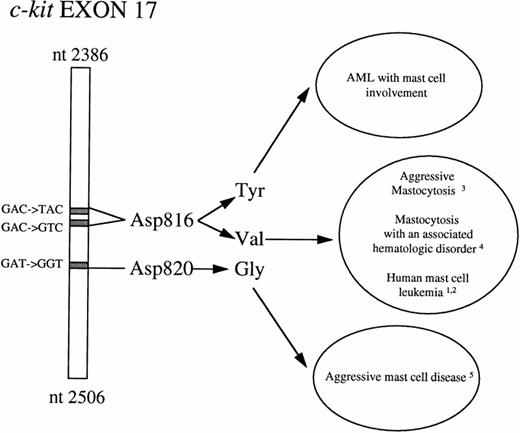To the Editor:
Activating mutations of c-kit proto-oncogene have been causally related to neoplastic transformation of mast cell lineage. The first evidence in humans was found in mast cell leukemia cell line HMC-1 with the detection of two mutations in codons 560 (V560G) in the juxtamembrane domain and 816 (D816V) in the cytoplasmic domain of c-kit, resulting in ligand-independent activation of the c-kit product.1 The predominant effect of D816V could be established by functional studies that demonstrated its pathogenetic role in mast cell transformation.1,2 Confirmation of this finding soon came with the identification of D816V in transformed mast cells from a patient with aggressive mastocytosis3 and lymphocytes from patients with mastocytosis and an associated hematological disorder.4 The recent identification of a nearby mutation D820-G in aggressive mast cell disease5 points to the fact that c-kit exon 17 and in particular codon 816 is a hot spot for activating mutations (Fig 1). A puzzling question raised by these studies is whether c-kit activating mutations have only a primary role in mast cell transformation, as described, or whether they may also be a secondary event occurring in hematopoietic cells other than mast cells. Bone marrow mastocytosis in AML-M2 with t(8;21) has recently been described as a new characteristic association of unknown pathogenetic significance.6 Previous findings by Valent et al7 defined a unique form of myeloblastic transformation in myelodysplasia and chronic myeloid leukemia characterized by spontaneous factor (MGF)-independent growth/differentiation of mast cells. Although the investigators could not provide any molecular evidence for their observations, they suggested that there might be a cellular MGF-independent defect (a point mutation in the MGF or MGF-receptor/c-kit genes) leading to evolution of mast cells from a malignant clone. We believe this rationale can be supported by the unique case we are reporting on here. We have identified a novel c-kit mutation (D816Y) in peripheral blood cells from a patient with acute myeloid leukemia (AML) of the M2 subtype, characterized by the massive presence of mast cells in bone marrow and rapid progression of the disease. The mutation, a G → T transversion at nt 2467 of the c-kit gene resulting in Asp816 → Tyr substitution (Fig 1), corresponds to the D814Y mutation identified and characterized in the murine P815 mastocytoma cell line.8Stem cell factor (SCF) transcripts were not detected by reverse transcription-polymerase chain reaction in leukemic blasts from bone marrow and peripheral blood from the patient. This finding indicates that the massive mast cell growth and differentiation observed in the patient's bone marrow is not dependent on SCF stimulation. Thus, the c-kit activating D816Y mutation leads to independent SCF growth like its murine D814Y counterpart1also in humans.
Exon 17 of human c-kit. Hot spot for activating mutations in mast cell disease.
Cytogenetic analysis on the patient's blasts showed a 47, XY t(8;21) +4 karyotype in all the metaphases analysed. The concomitance of two AML-specific chromosomal changes and D816Y kit mutation raises the question of their timing and role in the onset and evolution of leukemia in the patient under study. Translocation t(8;21) has proved to play a primary role in M2 acute myeloid leukemia9 and the blast immunophenotype clearly pointed to this event being a primary one in our case. Based on the cytofluorimetric finding of a subset of CD117+ blasts (23%) in our patient, we argue that the D816Y mutation was a secondary event occurring in a proliferating CD117+ myeloid subclone responsible for the spontaneous mast cell differentiation. The effect of D816Y on Kit signaling may be further enhanced by trisomy of chromosome 4 (carrying the c-kit gene). We favor the hypothesis that the c-kit activating mutation preceded trisomy formation, which then contributed an increased dosage of the mutated allele. Although this awaits a direct demonstration, the results obtained on murine skin tumors carrying trisomy 7 and a double dosage of activated Ha-ras10 provide further grounds for this hypothesis to be considered. Evidence accumulated so far on c-kit activating mutations in man points to c-kit being involved in oncogenic conversion of mast cells. In any case, the cooperation of c-kit with other cancer genes to support proliferation of leukemic blasts is exemplified by the unusual case described here and also by data on c-kit expression in most cases of AML.11 The pattern of expression of c-kit activating mutations probably depends on their timing compared with other leukemogenic events and the target cell type in which the mutant gene product accumulates.


This feature is available to Subscribers Only
Sign In or Create an Account Close Modal